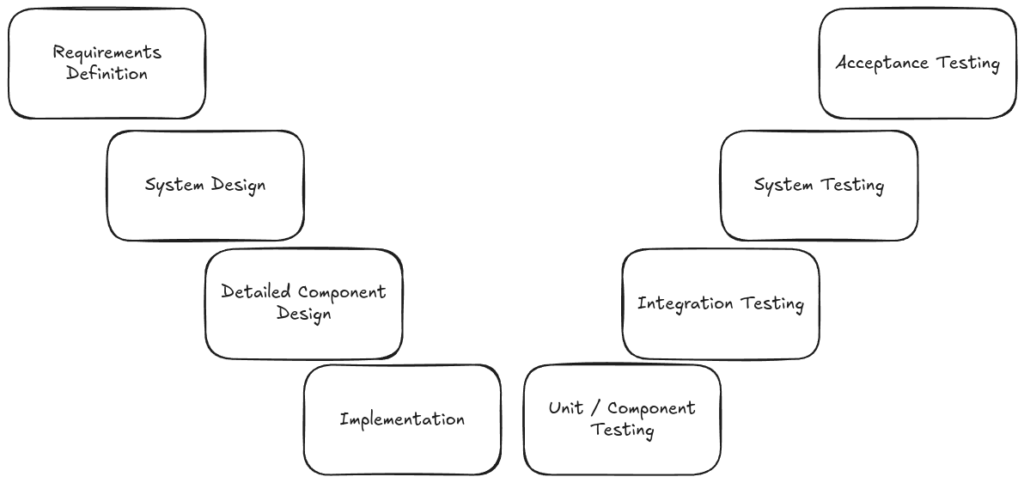Below is a sample page from the Key Engineering Knowledge Base created to help small teams build products faster. Please let me know what you think.
Would this help your team understand the concept quickly?
Overview
The Systems Engineering V-Model is a structured framework used to guide the development of complex systems, ensuring that each stage of design and implementation is directly linked to a corresponding phase of verification and validation.
Its distinctive “V” shape visually represents the relationship between development activities on the left side and corresponding testing activities on the right, emphasizing traceability, risk mitigation, and quality assurance throughout the system life-cycle.
Table of Contents
- Key Principles
- Structure of the V-Model
- How the V-Model Works
- Advantages
- Limitations & Risks
- Frequently Asked Questions
- Related Notes
- References & Resources
Key Principles
- Verification and Validation: Each development phase is paired with a corresponding test phase to ensure requirements are met and the system functions as intended.
- Traceability: Every requirement is linked to design elements and test cases, ensuring nothing is overlooked.
- Sequential Progression: The model follows a logical sequence from requirements gathering to final validation, reducing risks and improving project outcomes.
- Risk Mitigation: Early and continuous testing helps identify and resolve issues before they escalate.
- Configuration Management: Each phase’s outputs are baselined and put under configuration management, supporting traceability and change control.
Structure of the V-Model

The V-Model consists of two main streams:
Development/Specification Phases (Left Side)
- Requirements Definition: Gather and document user needs and system objectives.
- System Design: Develop a high-level architecture, defining system components and interfaces.
- Detailed Component Design: Break down the system into detailed components/modules and design each in-depth.
- Implementation: Build or code the actual system components.
Testing/Validation Phases (Right Side)
- Unit/Component Testing: Test individual components for correct functionality.
- Integration Testing: Test the interaction between integrated components to ensure correct collaboration.
- System Testing: Validate the complete system against the original requirements, including functional and non-functional aspects.
- Acceptance Testing: Final validation in the real-world environment to confirm the system meets user needs and requirements.
How the V-Model Works
The V-Model’s core strength lies in its mirrored structure:
- Each development phase on the left has a corresponding testing phase on the right.
- For example, requirements defined at the start are validated during acceptance testing; components designed in detail are verified through unit testing.
- This ensures continuous alignment between what is built and what is tested, promoting early defect detection and reducing rework.
Advantages
- Clear Structure: Offers a straightforward, visual approach to managing complex projects.
- Quality Assurance: Systematic verification and validation at every stage ensures high-quality outcomes.
- Improved Traceability: Easy to track requirements through design, implementation, and testing.
- Risk Reduction: Early testing and validation reduce the likelihood of costly errors later in the project.
Limitations & Risks
- Inflexibility: The sequential nature can make it difficult to accommodate changes once the process is underway.
- Time-Consuming: Comprehensive documentation and testing can extend project timelines, especially for large projects.
- Easily Over-Complicated: Without careful attention to scope teams can spend too much time and energy focusing on the wrong details or writing too much documentation that feels like making progress but doesn’t produce high value.
Frequently Asked Questions
How Can Small Teams Use the V Model Effectively?
- Leverage the V-Model’s Structure for Clarity and Alignment
- The V-Model provides a clear, step-by-step framework, which is ideal for small teams needing structure and well-defined deliverables.
- Each phase has specific outputs, making it easier to delegate tasks, track progress, and ensure nothing is overlooked.
- Focus on Projects with Clear, Stable Requirements
- The V-Model works best when requirements are well understood and unlikely to change.
- For small teams, this reduces the risk of rework and helps keep the project on schedule and within budget.
- Integrate Development and Testing Activities
- Small teams often have overlapping roles; the V-Model’s pairing of each development phase with a corresponding test phase ensures early and continuous validation.
- This approach helps catch defects early, saving time and resources.
- Keep Documentation and Processes Lightweight
- Avoid heavy bureaucracy. Use concise documentation and simple tools (shared docs, checklists) to maintain traceability and clarity without slowing the team down.
- Focus on essential documentation that supports both development and future maintenance.
- Customize Phases to Fit Team Strengths
- Tailor the V-Model phases to your team’s expertise and project needs.
- For example, combine or streamline phases if roles overlap, and automate repetitive tasks where possible to maximize efficiency.
- Promote Communication and Stakeholder Involvement
- The V-Model’s structure encourages regular reviews and checkpoints, which are opportunities for team members and stakeholders to align and clarify expectations.
- Encourage questions and open communication to address uncertainties early.
- Continuously Monitor and Improve
- Regularly review your process and adapt the V-Model as your team learns what works best.
- Use retrospectives to refine your approach and address any bottlenecks or pain points.
Does using the V Model conflict with Agile Development?
No. These development models both work well together. By combining Agile Development and the V-Model teams can build products faster. Agile Development is all about high frequency of customer feedback and smaller iterations. This pairs well with the V-Model since one of the biggest risks is when teams accidentally add too much detail and complexity.
Related Notes
References & Resources
- V-model – Wikipedia
- Agile V-Model – digitalplaybook.org
- Fantastic example of the V Model broken down in an agile fashion for an autonomous robot.
- Vee Life Cycle Model – SEBoK


Leave a Reply